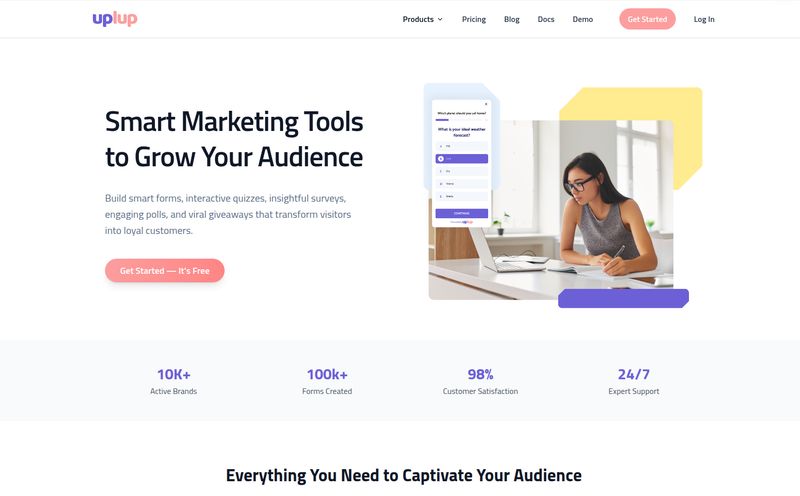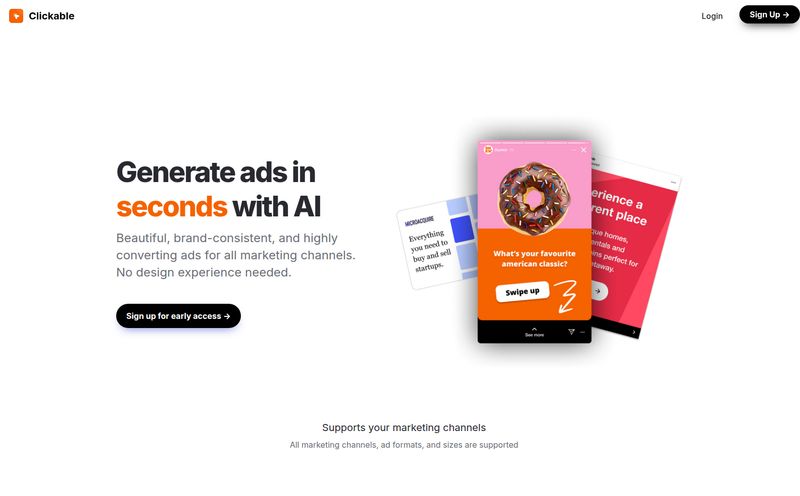The print-on-demand world is a grind. You're constantly chasing trends, trying to out-design the competition, and feeding the insatiable beast that is social media marketing. Some days it feels less like a creative outlet and more like a high-speed content treadmill. You know the feeling. You spend hours in Canva or Photoshop, finally create a design you love, only to see five similar ones pop up on Etsy an hour later.
So, when a tool comes along promising an "unfair advantage," my ears perk up. My skepticism does, too, but that's a story for another day. The tool in question is Wondr AI, a platform that claims to automate huge chunks of the POD workflow. We're talking creating thousands of products from a single prompt and then marketing them for you. Sounds a bit like magic, right? I had to see what was under the hood.
What on Earth is Wondr AI, Anyway?
At its core, Wondr AI is an artificial intelligence platform built specifically for us folks in the print-on-demand trenches. The big idea is to take the most time-consuming parts of the job—design creation and marketing—and hand them over to an algorithm. Instead of you personally designing a t-shirt, a pair of socks, and a backpack, you give Wondr AI a single idea, a prompt, and it generates an entire product line for you. It's like having a brainstorming team, a graphic designer, and a social media intern all powered by a single line of text.
But it doesn't stop at just making the pretty pictures. It also creates the mockups, writes the social media captions, and even generates relevant hashtags to go along with them. The goal is clear: speed. It wants to take you from idea to a live, marketed product in a fraction of the time it normally would.
How Wondr AI Delivers Its "Unfair Advantage"
Okay, so "unfair advantage" is a bold marketing claim. Let's break down what Wondr AI actually does to back that up.
From a Single Prompt to a Full Product Line
This is the headline feature. You've seen AI image generators like Midjourney or DALL-E. Wondr AI takes that concept and applies it directly to product templates. You can see it in their dashboard: socks, watch bands, shorts, bags. You type in a prompt like, "a pattern of cute, cartoon corgis wearing sunglasses," and the AI gets to work, not just creating the pattern but applying it to a whole range of products. This is a massive time-saver. No more manually resizing and adjusting a design for ten different product specs. It's a game-changer for anyone looking to build a large, diverse catalog quickly.
Putting Your Marketing on Autopilot
Creating the product is only half the battle, as we all know too well. Getting eyes on it is the other, arguably harder, half. Wondr AI attempts to solve this by automating the creation of marketing assets. It generates those slick, professional-looking mockups that are crucial for sales. More than that, its AI will write your Instagram or Pinterest captions and come up with a list of hashtags. While I’d always recommend giving these a human once-over, it can slash the time you spend staring at a blank caption box, wondering what to write.

Visit Wondr AI
The Automation Glue: Integration with Make.com
Now this, for me, is where things get really interesting. Wondr AI integrates with Make.com (formerly known as Integromat). If you're not familiar with Make, it's a powerful tool that lets you connect different apps and automate workflows. This integration means you can create some seriously complex automations. For instance, you could set up a scenario where every time Wondr AI creates a new product line, it automatically pushes those products to your Etsy store, drafts a blog post on your Shopify site, and schedules a week's worth of promotional posts on Pinterest. This moves Wondr AI beyond being just a design tool and turns it into the central engine of a fully automated POD machine. This is where that 'unfair advantage' claim starts to feel a little more real.
The Good, The Bad, and The AI-Generated
No tool is perfect, right? Especially in the fast-moving world of AI. After digging in, here's my honest take.
On one hand, the speed is undeniable. The ability to populate a store with hundreds of products in a day is something that would have been pure fantasy a few years ago. For sellers focused on quantity and trend-chasing, this is incredible. And for those of us who aren't trained graphic designers, it removes a massive barrier to entry. The automated marketing is the cherry on top, tackling one of the biggest time-sinks for any solo entrepreneur.
However, I have my reservations. Relying solely on AI for design quality is a gamble. AI can be brilliant, but it can also be... weird. We've all seen AI-generated images with six-fingered hands or bizarre, nonsensical text. You still need a human eye for quality control. There's also the question of uniqueness. If thousands of users are using the same AI with similar prompts, how do you stand out? The platform's real power for customisation seems tied to your ability to craft truly unique and complex prompts. And let's be honest, the full automation potential is heavily dependent on you knowing your way around a tool like Make.com, which has its own learning curve.
So, What's the Price Tag?
This is where things get a little... amusing. As I was researching for this article, I clicked on what I assumed was the pricing page. And what did I find? An "Oops! Page Not Found" error. You can see it in the screenshot I grabbed. Honestly, it made me chuckle. It's a humbling reminder that even the most futuristic AI platforms are still run by humans and, sometimes, links break. It's the kind of authentic hiccup you don't get from a massive, established corporation. As of writing this, there's no public pricing information available. This usually means the platform is in an early-access phase, beta testing, or preparing for a big launch. I’d expect a tiered subscription model, maybe based on the number of designs or social media posts per month. Your best bet is to head to their site and sign up for their waitlist or "Get Started" flow to get the latest info.
Is Wondr AI the Right Tool for Your POD Business?
So, who is this really for? I see a few key groups who could get a lot out of Wondr AI.
- The Volume Seller: If your strategy is to capitalize on micro-trends and upload a high volume of designs, Wondr AI could be your new best friend.
- The Non-Designer: If you have great ideas but lack the technical skills in Photoshop or Illustrator, this tool could finally bring your vision to life.
- The Automation Nerd: If you're already comfortable with tools like Make.com or Zapier, the integration possibilities here are genuinely exciting. You could build a business that practically runs itself.
However, if you're an artist or designer whose brand is built on a unique, handcrafted aesthetic, this might not be for you. The strength of Wondr AI is speed and scale, not necessarily creating a one-of-a-kind artistic masterpiece.
Frequently Asked Questions about Wondr AI
Do I need any design skills to use Wondr AI?
Nope! That's one of its main selling points. The platform is designed for users to generate designs using text prompts, completely removing the need for traditional design software or skills.
Can I customize the designs Wondr AI creates?
Customization is primarily done through the detail and creativity of your prompts. The platform itself may have limited post-generation editing tools, as its focus is on speed and automation. The real control comes from how well you can describe your vision to the AI.
What platforms does Wondr AI integrate with for marketing?
The platform is designed to automate posts for major social media channels. Through its deep integration with Make.com, you can theoretically connect it to almost any platform that Make.com supports, including Etsy, Shopify, Pinterest, Instagram, and more.
Is Wondr AI free?
It's unlikely to be completely free. While the pricing page is currently unavailable, tools this powerful typically operate on a monthly subscription model. They may offer a free trial or a limited free tier when they launch fully.
Will my designs look like everyone else's?
This is a valid concern with any AI tool. The uniqueness of your designs will depend heavily on the uniqueness of your prompts. Combining different concepts, styles, and subjects in your prompts will be the key to creating a distinct look and avoiding a generic, "AI-made" feel.
Final Thoughts: A Glimmer of the Future?
So, is Wondr AI truly an "unfair advantage"? Maybe. For the right person, it absolutely could be. It's a powerful glimpse into the future of e-commerce and creative work. The idea of abstracting away the most repetitive and time-consuming tasks is incredibly appealing. It won't replace the need for good ideas, a strong brand voice, and a human touch for quality control. But it can act as a massive force multiplier, freeing you up to focus on the things that really matter: finding the next big trend, engaging with your community, and actually building a brand instead of just being stuck on the content treadmill. It’s a tool I’ll be keeping a very close eye on. And hey, maybe next time I check, the pricing page will even work.
References and Sources
- Make.com Official Website - For information on the automation platform Wondr AI integrates with.
- Wondr AI's official website (based on provided information).



